Remanufacture, refurbishment, reuse and recycling of vehicles: trends and opportunities
This report describes the short, medium and long term trends related to the remanufacturing, refurbishment, reuse and recycling of vehicles, parts and components in Scotland.
3. Current situation in Scotland
This section considers the current situation in Scotland, focusing mainly on how ELV dismantlers and shredders are responding now, and in the short term, to the 2015 ELV Directive targets.
Firstly, a summary of the current ELV dismantling and shredding sector is provided, including an overview of the relevant legislation and sector structure. The remainder of the section details the results of an in-depth interview programme that obtained feedback from the majority of Scottish based ATFs on their current practices, processes and future plans.
3.1 Relevant regulations and industry structureThe UK Government has introduced a number of regulations to transpose the EU ELV Directive into UK law:
- The End-of-Life Vehicles Regulations 2003
- The End-of-Life Vehicle (Producer Responsibility) Regulations 2005
- The End-of-Life Vehicles (Amendment) Regulations 2010
- The End-of-Life Vehicles (Producer Responsibility) (Amendment) Regulations 2010
The 2003 and 2005 regulations are complimentary and the 2010 regulations make largely technical amendments to the 2003 and 2005 regulations [33] .
The 2005 regulations introduced two targets for reuse and recycling of ELVs. These are aligned with ELV Directive targets and apply at a UK level:
- Regulation 18(1) of the 2005 regulations sets a target of 80% reuse and recycling and 85% reuse and recovery during 2006 and in subsequent years
- Regulation 18(2) of the 2005 regulations sets a target of 85% reuse and recycling and 95% reuse and recovery during 2015 and in subsequent years
These targets apply to producers through their collection networks and to ATFs where vehicles are treated independent of any agreement with producers.
In addition to the above UK regulations, Scotland has introduced the 'End-of-life Vehicles (Storage and Treatment) (Scotland) 2003' which relate to licence conditions for the storage and treatment of ELVs in Scotland.
The system developed under the UK regulations provides "free take back" under producer responsibility (2005 regulations). The vehicle manufacturers and importers use two companies to contract with a compliance scheme. These companies award contracts on behalf of the manufacturer to chosen Authorised Treatment Facilities. The ATF then provides a "free take back" service for the manufacturers as directed by the compliance scheme and reports back on recycling and recovery performance.
Over 50 ATFs in Scotland are contracted to vehicle manufacturers through the two compliance schemes. Collectively, these ATFs treated over 70,000 ELVs in 2011 and demonstrated the 85% reuse and recovery target was met on them. There is some cross over between ownership of shredders in Scotland and affiliation to one or other of the compliance schemes (in some cases the Directors of shredder companies are also Directors of a compliance scheme) [34] .
Authorised Treatment Facilities
The ELV industry in Scotland is characterised by a large number of vehicle dismantlers and a small number of shredders. Dismantlers can be specialist businesses focusing predominately on ELVs or they can be part of larger metal trading businesses. They generate revenue through the removal of parts and components for reuse, refurbishment and remanufacture and also through the sale of the depolluted and dismantled hulks to shredder operations. Some dismantlers offer recovery and collection services for ELVs in their local area and some also offer fitting services for reused parts and components.
Shredders mechanically reduce the ELV hulks to small pieces and automated equipment sorts this into different metallic fractions. In addition to treating an estimated 100,000 ELVs annually [35] the shredders also process other end of life products, such as WEEE, in a continuous process. This means that the output material is made up of more than just materials contained within ELVs.
To operate as an ATF in Scotland the business has to be licensed by SEPA. Currently there are 137 ATF sites in Scotland. There are also believed to be a significant number of unauthorised operators working outside of the licensing system. These unauthorised operators seek to purchase ELVs and profit through their sale as scrap metal without carrying out the required depollution steps.
The waste management licence requires a site infrastructure that contains an area of impermeable surfaces (with sealed drainage system if in an open space). All non-depolluted ELVs must be stored on this surface and any depollution activity must be carried out on this surface. The licence attracts an annual fee.
Depollution Process
The requirements of depollution are detailed in statutory guidance [36] . This guidance, from the lead government department, BIS, states the required levels of depollution and the activities and processes that have to be carried out to achieve "full depollution". This includes removal of all fuels and fluids, batteries, explosive components and mercury components.
The guidance does not prescribe the manner in which the process achieves the depollution or the equipment to be used; this is left to the operator to choose.
Once fully depolluted, the ELV can be stored for future removal and sale of used spare parts.
At the stage where the ELV is no longer required for parts, the total hulk, including all parts not removed for re-sale, is sold to a scrap metal merchant or directly to a shredder operator for recycling.
3.2 Reprocessing infrastructure and capacity
3.2.1 Geographical spread of ATFs
The geographical location of the 137 ATFs in Scotland is shown in the map at figure 16.
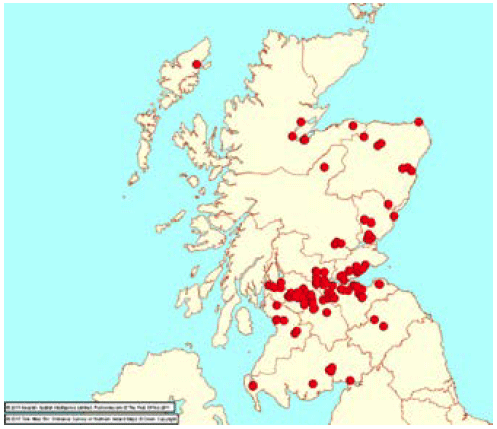
Figure 16 - Map of Scottish-based ATFs
The above map shows the concentration of ATFs around the main population areas of Scotland, as would be expected. There are an additional two ATFs located in the Shetland Isles.
The original database of ATFs, accessed via the SEPA website, had 145 entries. During the research process seven duplicate entries were identified resulting in a total population of 137. Of this:
- 72 dismantlers were interviewed (via the structured survey) - 53%
- 4 large shredders were interviewed (face-to-face or in-depth telephone interview) - 3% of all ATFs but these are the four largest shredders in Scotland
- 24 refused to participate (mainly stating lack of time) - 18%
- 4 stated they no longer processed ELV - 3%
- 33 were contacted on at least 5 occasions but were unavailable - 24%
Feedback was, therefore, obtained from 56% of ATFs (by number).
3.2.2 Number of operational sitesThe majority of ATFs in Scotland are single site operations (90% of the survey response) as shown in the figure below.
Figure 17 - Number of sites covered by ELV operations (72 responses)
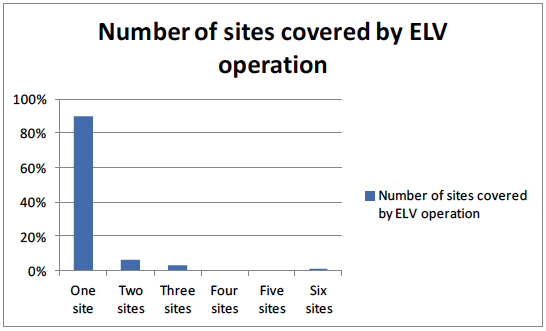
Figure 17 shows the structure of the industry is predominately based on single site operations.
3.2.3 Employment in ATFs
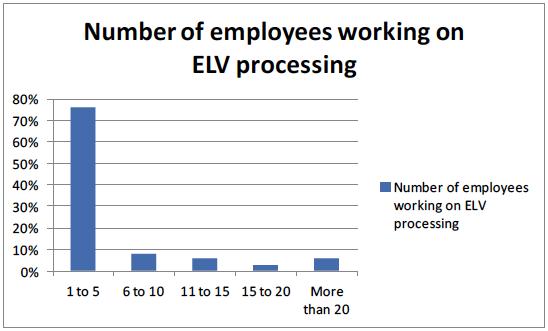
Figure 18 - Number of employees working on ELV processing (71 responses)
Around three quarters of ATFs have between 1 and 5 employees. A total of 370 employees were found to be working on ELVs from the 71 respondents who provided data. On average each ELV operation employed 5 people.
3.2.4 ELVs processed at ATFs and capacitiesA total of 65 of the 72 survey respondents provided information on the number of ELVs processed in 2011. In total, the sample estimated that 68,355 ELVs were processed in that year, an average of just over 1,000 ELVs per ATF (with the responses ranging from as low as 10 to as high as 9,000). Comparing this to the estimated 96,717 ELVs processed by ATFs in 2011 suggests that the survey respondents accounted for 70% of ELVs treated in Scotland in that year. This does not include the ELVs processed by the seven respondents who answered 'don't know' to this question. A number of ELVs will also have been processed directly by the four shredders interviewed (and this proportion of ELVs is not included in the 70% identified above).
A total of 65 of the 72 survey respondents provided data on the capacity of their ELV operations. On average, ATFs are working at 63% of capacity (ranging from 3% to 100%). Comparing capacities to their 2011 estimates of numbers of ELVs processed suggests that the 65 ATFs responding to this question could deal with an additional 23,770 ELVs with current operations.
3.2.5 ELV Practices and ProcessesA total of 68 of the 72 respondents stated that they dismantled ELVs on site. Of those that stated they did not dismantle, one had been taken over in 2011 and was currently changing their approach to ELVs and the remaining three uplifted and passed on down the supply chain.
This section should be read in the context of the legal requirement to undertake specified depollution processes, including the removal of [37] :
- Any batteries.
- The liquefied gas tank.
- All potentially explosive components, including air bags.
- All fuel, motor oil, transmission oil, gearbox oil, hydraulic oil, cooling liquids, antifreeze, brake fluids, air conditioning system fluids and any other fluid contained in the vehicle (excluding any fluid which is necessarily retained for the re-use of the part concerned).
- So far as is feasible, all components identified as containing mercury.
In addition to the above specific legal requirements relating to the ELV directive, the recovery of ozone depleting substances ( i.e. gases such as CFCs) from air conditioning units is also a legal requirement under 'The Environmental Protection (Controls on Ozone-Depleting Substances) Regulations 2011' with the qualifications of persons carrying out the relevant work defined in 'The Ozone Depleting Substances (Qualification) Regulations 2009'. Advice from industry stakeholders indicates that only specialist air conditioning gas recovery equipment is suitable to comply with these regulations.
Current processing equipment
The 68 that stated they do dismantle were asked to identify the processing equipment they currently had available at the ELV site. Figure 19, shows the spread of responses:
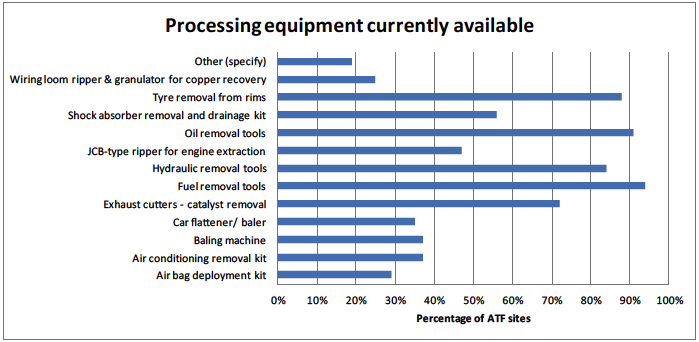
Figure 19 - Processing equipment currently available at ELV sites (68 responses)
The use of air conditioning removal kit is low given that the removal of air conditioning gases is a legal requirement (and can only be properly carried out using specialist equipment). This suggests that even within authorised ATFs the depollution processes do not appear to be fully compliant with legislation out at some sites. It may be that there is a lack of awareness of the need to remove air conditioning gases as this is mandated by different legislation, as detailed on the previous page. This may be an area for further development to increase awareness of the legal requirements relating to the removal of air conditioning gases in particular and overall depollution in general. Such awareness raising could include advice on the types of equipment and training necessary to comply with legislation.
The 'other' equipment specified by respondents included:
- Hire in a baler as and when we need it
- Normal tools we use for repairing cars and replacing parts
- Special decontamination unit
- Jaws of life (hydraulic cutting/spreading tool)
- Holmatro hydraulic cutting tool
- Autodrain Equipment
- Run of the mill processing equipment
- Granulators
- Cable stripper
- De-pollution and removal tools
The equipment used is common and is developed and sold by both UK and European manufacturers. Feedback from industry is that there is no equipment or practices used in Europe that are not known to UK industry. Latest developments are promoted and shared through specialist industry websites [38] and trade shows.
Manual removal of vehicle parts
Figure 20 summarises current practice in manual removal by part and/or material type.
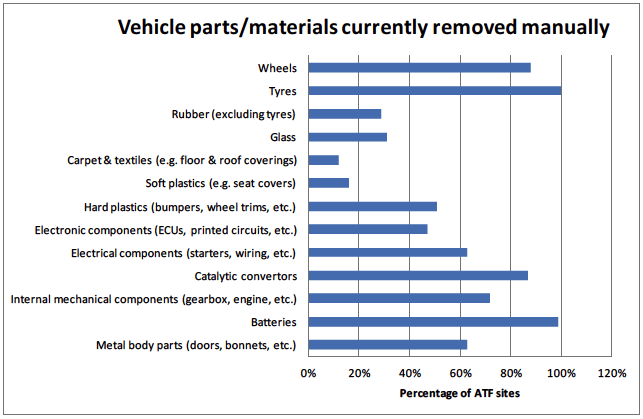
Figure 20 - Vehicle parts/materials currently removed manually (68 responses)
The manual removal referred to in the above figure includes where parts are manually removed from some or all ELVs. The breakdown between the two is shown in figure 21.
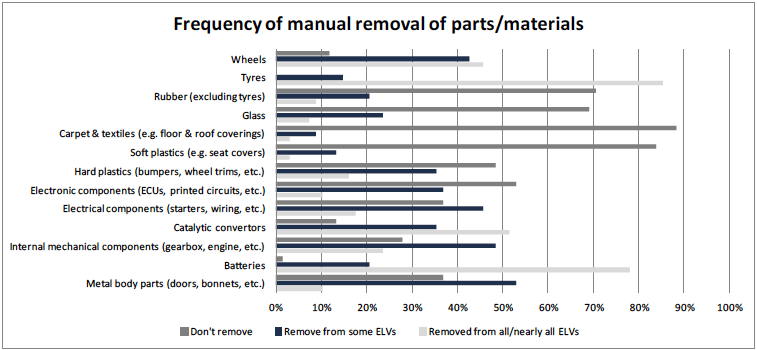
Figure 21 - Frequency of manual removal of parts/materials of ELVs (68 responses)
Industry stakeholders expressed a level of surprise that the survey results suggested a significant amount of batteries and catalytic convertors were not removed, as these parts have value to a reprocessor and are a mandatory part of the depollution process.
Onward use of manually removed parts/ materials
Those respondents who stated that they manually removed parts/materials from ELVs were asked to identify whether this was carried out for reuse, recycling or energy recovery. Figure 22 summarises the response.
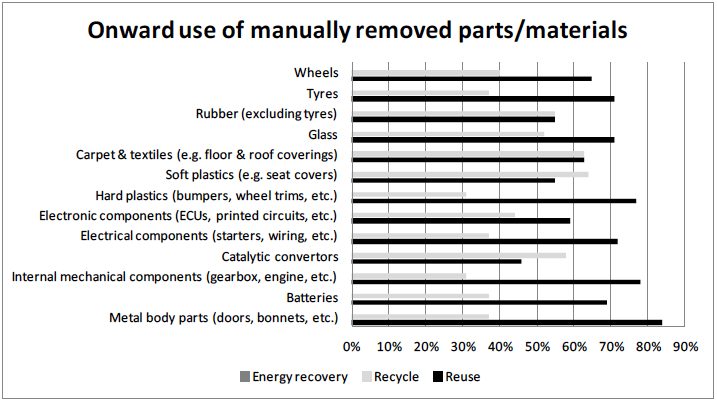
Figure 22 - Onward use of manually removed parts/materials (responses from those who manually remove - not the total sample)
Note that total percentages can exceed 100 in circumstances where ATFs both reuse and recycle parts/materials. Further feedback from the material reprocessing sector suggests that some materials are used for energy recovery, for example tyres used to fuel cement kilns (even though no ATFs stated this was the case). This could be due to an understandable lack of knowledge by the ATF on what the reprocessor uses certain parts and materials for. The markets for the parts and materials are discussed in section six.
3.3 Material flowsThis section describes the geographical location of the customers, to which parts/materials are sold by ATFs. Clearly, sales could be made to intermediaries and the part/material could then be sold again to different geographical locations. This analysis refers only to the first transaction between ATFs and their customers.
3.3.1 Location of customers for parts/ materials sold by dismantlersRespondents were asked to identify the approximate percentage of sales of the part/materials that were removed manually. The response options were 'Scotland', 'Rest of UK' and 'Exported'. The responses were then aggregated to obtain an estimate of the average geographical location of onward sales. This calculation weighted the individual response by the number of ELVs treated in 2011 (which assumes that each ATF that manually removes the respective part/material does so at the same rate). The results are summarised in figure 23, below.
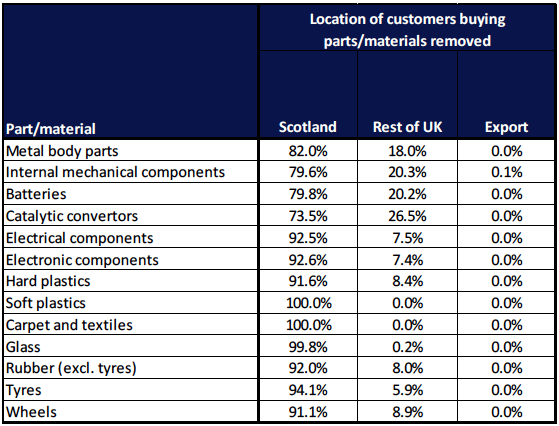
Figure 23 - Location of customers, by part/material manually removed
It should be noted that the above data regarding location of customers buying materials and parts refers only to the first onward sale by the ATF. Further investigation, of the companies named by the ATFs, indicates that a high proportion of these are collectors and aggregators who then sell on to others, frequently outside Scotland, for reprocessing.
It should also be noted that figure 23, above, refers to the first onward sale of parts and materials actually removed from the ELVs not those present on the vehicle itself. For example, 82% of metal body parts are sold to customers in Scotland but this only refers to those metal body parts which are removed prior to shredding.
After depollution and subsequent manual removal of parts and materials, the ELV carcasses are then processed mechanically to retrieve metals. Figure 24, below, shows the geographic location of the customers who buy these carcasses from ATFs.
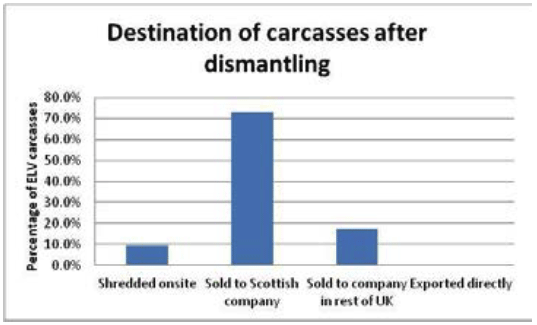
Figure 24 - Destination of ELV carcasses after depollution and dismantling (60 responses)
Data in figure 24 are from the structured survey and, therefore, do not include the four largest shredders in Scotland (who were interviewed separately). Six respondents to the structured survey indicated that they had onsite shredding capacity. It is estimated that these six companies shredded 6,400 ELVs in 2011.
3.3.2 Arisings and treatment of ASR from shreddersOn the basis that the shredding/fragmentising industry in Scotland, and beyond, is going to be one of the key sectors in a successful shift from 85% to 95% recycling/recovery, the four main shredder operations were interviewed to review current practice in terms of volumes handled and amounts landfilled. The outcome of that feedback is summarised below, showing estimates of annual input of ELV materials, amounts recycled and ASR landfilled.
| Shredder (conf. reference no.) | Annual Input of ELV Materials (tonnes) | Annual Amount Recycled (tonnes) | Annual ASR Amount Landfilled (tonnes) | Comment |
|---|---|---|---|---|
| 1 | 30,000 | 24,000 | 6,000 | Operator's calculated annual figure. Of the 6,000 they feel further diversion can be achieved. Progress possible in more metal recovery (37% of total); Plastics (17%); Rubber (9%); Foams (6.5%), and; Wood (4.5%). Trials of ASR composition have been carried out. |
| 2 | 20,000 | 15,000 | 5,000 | This operator indicates 55% of tonnage from ELVs and 45% from other scrap, but that will vary dependent on the construction industry. The majority of the other scrap is sheared or aggregated in bulk separately from the ELV waste. Recent investment in end of line metal recovery (type of equipment is confidential to the shredder). |
| 3 | 19,000 | 15,100 | 3,900 | This operator has substantial other tonnage going through the shredder, but ELV figures are kept separately and these provided as up to date figures. |
| 4 | 28,700 | 23,250 | 5,450 | These figures taken from 2010 SEPA data. |
| Total | 97,700 | 77,350 | 20,350 | This figure is ELV based. See Note below. |
Figure 25 - Estimated ELV material flow through four large Scottish shredders
Note: The above data are from company interviews and/or SEPA 2010 returns, dependent on the degree of accuracy assumed during the survey. The figures focus on waste from ELVs; but it should be noted that the total input of all material delivered to these sites and processed by them seems to be greater than ELVs alone. It is estimated that total shredder residue ( SR) arisings ( ELV, WEEE, etc.) in Scotland are around 60,000 tonnes per annum.
3.4 ELV resource valueTypical values at each stage of the chain include:
- Consumers typically sell their car to a recycler for around £150
- The recycler/dismantler extracts what value they can from the vehicle. This is estimated at £100 per ELV, on average, although lower and upper ranges can vary considerably. For example, the same part for a Ford Fiesta will be cheaper than that for a Mazda MX5
- Approximate values (typically used in the dismantling sector) for parts and components sold for reuse are:
- 20% of the cost of a motor manufacturers original equipment price, e.g. bought from Ford main dealer
- 50% of cost against a new part manufactured independent of original equipment manufacturers
- Approximate values (typically used in the dismantling sector) for parts and components sold for reuse are:
- Dismantlers then sell the depolluted hulk onto a shredder at a price ranging from £125 - £175/tonne
- Shredder operators can currently expect to achieve around £260 per tonne for ferrous metals and an average of £1,000 per tonne for non-ferrous metals (average across a range of non-ferrous materials)
More detail on the values used for the model projections part of this project is provided in section eight.
3.5 Barriers to increased recycling/recovery and valueSome of the key barriers to increased recycling/recovery are described below.
3.5.1 Competition from unauthorised/non-compliant operators restricting investmentThere are two linked issues which contribute to this barrier. Firstly, there is the competition from unauthorised operators who do not have the appropriate waste management licences and are not authorised to issue Certificates of Destruction ( COD). Secondly, there is competition from authorised operators who do have the necessary waste management licences but do not fully comply with the mandatory depollution processes.
The COD is a key element of the ELV Directive. It is issued to the last owner of the ELV as a proof that the vehicle has been properly treated by an ATF. The document is proof that the ELV has been deregistered by the vehicle licensing authority ( DVLA). It is also the mechanism by which the recycling and recovery performance is measured.
Feedback from the dismantling sector highlights their belief that the number of CODs issued is significantly below the true number of ELVs entering the waste stream. Current figures for COD's issued in the UK are in the region of 1,200,000 (for 2010). In addition to this there were over 290,000 second-hand car exports in the same year [39] . Representatives of the dismantling sector estimate that the number of ELVs that arise per annum in UK is around 2,000,000.
The issuing of a COD can only be carried out by ATF with a waste management licence issued by the regulator. It is, however, possible for the last owner to inform the DVLA in writing, via form V5C, that the ELV has been scrapped. The DVLA then acknowledge that they have processed the V5C form. The DVLA does not appear to systematically cross-check its database for evidence of a COD being issued against the V5C forms received. In addition, there is no requirement on the V5C form for the last owner to confirm they been issued with a COD. The form does request details of the motor trader that ownership is being transferred to but feedback from dismantling industry representatives suggests that this is not systematically cross-checked to confirm a COD has been issued.
Cross-checking the last owners V5C form against the COD database would make it far harder for unauthorised operators to obtain scrap vehicles. This would, of course, require a change at a UK level based on the existing deregistration system (and potentially penalties or incentives for last owners connected to the successful receipt of a COD). The COD system issue is thought to occur in other European countries (to varying degrees).
The unauthorised operator is unregulated, potentially operates using methods which do not protect the environment and has a significant financial advantage i.e. no costs for permit, yard infrastructure, regulation, reporting, or in many cases VAT (although it could be the case that some businesses may not be a registered ATF but still pay VAT). In addition to this, there is the issue of authorised operators who do not comply fully with treatment standards ( e.g. they may not fully depollute the ELV prior to shredding) which also gives them a cost advantage over those ATFs which carry out a fully compliant depollution process. In the latter situation a COD can still be issued so the opportunity to overcome this would rely more on increasing awareness of the legally required depollution process complimented with monitoring and enforcement by the regulator.
3.5.2 Lack of market pull for non-metallic parts/materialsELV dismantlers are, by definition, driven by recycling. They respond to market demand for different parts/materials where there is an economic case to do so. Current market conditions mean that the natural focus of activity is on the recycling of metal. The more the metal can be segregated into different types, the higher the value that can be achieved. There is currently little market incentive to remove non-metallic materials unless the prices paid for the material are greater than the value paid by the shredder that purchases the carcass (around £125 - £175 per tonne).
Perceived quality of reused partsThe industry in the UK has, over the last three years, sought to have a quality specification for reused parts and components. The objective of this would be to increase the perceived quality of these parts and reduce the risk for consumers.
The proposed route was to create a Publicly Available Specification ( PAS). A PAS is a consensus driven framework under which goods and services can be supplied to a consistent minimum quality standard (this process is less onerous than a full quality standard but is still an instrument valued by the market). The aim of the PAS would be to provide an audit trial for the parts through its various processes i.e. details of donor vehicle testing (visual or mechanical), despatch process etc.
This PAS would then provide the purchaser (vehicle repair/bodyshops/motoring public) with an assurance that the company supplying the part has a management system in place to monitor the process and, therefore, gain confidence in the supply. The PAS would likely include a minimum guarantee that would need to be offered on reused parts and components.
The industry was unable to raise the necessary funding to create and gain accreditation for the PAS. The associated cost was in the area of £65,000 for the development of the PAS. In addition to this, industry feedback suggests that the cost of establishing a system to comply with a PAS would be around £2,000 to £5,000 per ATF.
3.6 Options identified by ATFs to add valueSurvey respondents were asked if there were things that could be done in Scotland or the UK to increase the value of recovered materials after processing. Figure 26, below, summarises the responses:
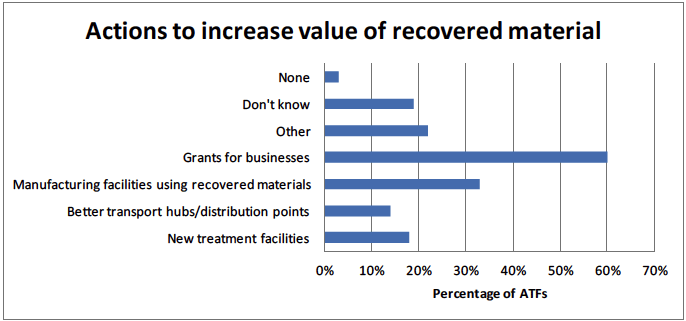
Figure 26 - Potential actions to increase value of recovered material in Scotland/ UK (72 responses)
Of those respondents who selected 'other' the following actions were proposed:
- More info on sites in Scotland that process parts and recycle materials
- More support from manufacturers on disposal of ELVs
- Recycling must be cost effective. Government has to be more supportive
- Price for scrap varies too much
- Make materials interchangeable as the materials are cheaper to buy from abroad
- Increase end markets
- Government allowances for smaller companies; by this I mean companies with 1 or 2 employees. The government think of small companies as having 200 employees not 2
- Stamp out illegal yards that operate where people don't pay taxes and can undercut us
- More Government financial support for recyclers
- A lot more government support than is currently offered
- Scotland needs to have major recyclers here, costs too much to send materials down south
- Stop speculators
- Consistent equal treatment. If we lived 2 miles away we would get grants for machinery but here we don't. It's a lottery situation with grants
- It's all too late for the industry now
- Too late, the government has done all the damage
- Outlets to get money for tyres rather than us having to pay for them to be disposed of. We have to pay 60p or 70p for a company to take these from us
There are a wide variety of responses. The common themes include more financial (and other) support from Government, the development of end markets and action against unauthorised operators.
3.7 Future plans of ATFs
3.7.1 Expectations about achieving the 2015 95% target
ATFs were asked if they expected to achieve the 95% recycling/recovery target by 2015. Figure 27, below, shows the responses.
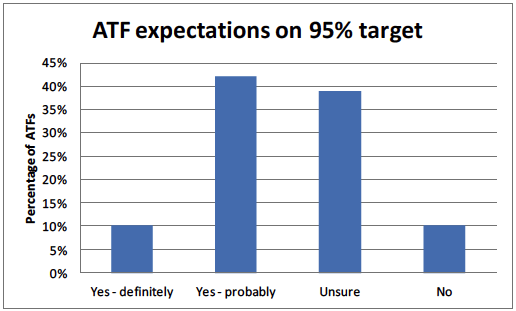
Figure 27 - Expectations of ATFs about their ability to achieve the 2015 95% target (72 responses)
The response shows a cautious optimism about achieving the ELV Directive target. No detail was requested in the structured survey about how the target would be achieved. This was discussed during the in-depth telephone and face-to face interviews and the issues and options are discussed in greater detail later in this report.
3.7.2 Investment plansATFs were asked about their future plans for investing in additional processing equipment. Figure 28, shows the responses.
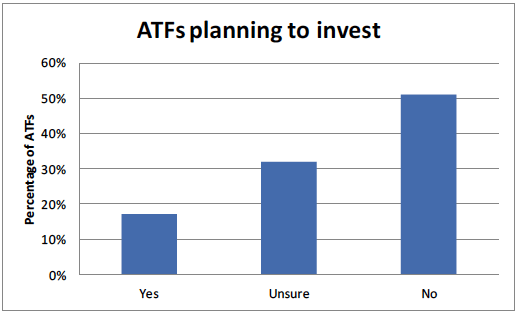
Figure 28 - ATFs planning to purchase additional ELV processing equipment
A total of 12 (17%) of the ATFs interviewed do have plans to purchase additional processing equipment, with a further 23 (32%) unsure. The remaining 23 (51%) said they had no plans to invest.
Of those not planning to invest the following reasons were given:
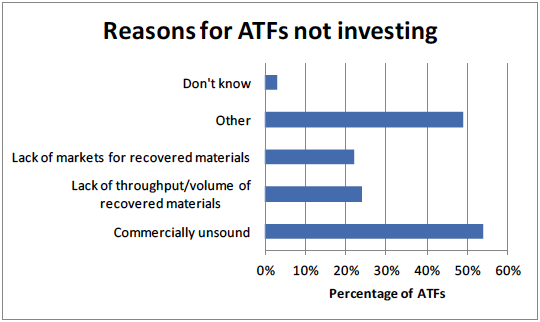
Figure 29 - Reasons for ATFs not investing in additional ELV processing equipment
Note that the percentages add up to more than 100 as respondents could select more than one reason. Clearly, these reasons can be interrelated. For example, a lack of throughput means there is insufficient material to interest buyers and, therefore, investment is commercially unsound. Other reasons given include not investing as lack of demand, operators leaving the sector through retirement and illegal operators.
The reasons given for planning to invest also included increasing the value from recycling and achieving regulatory compliance.
Figure 30, below, shows the types of equipment under consideration for future investment:
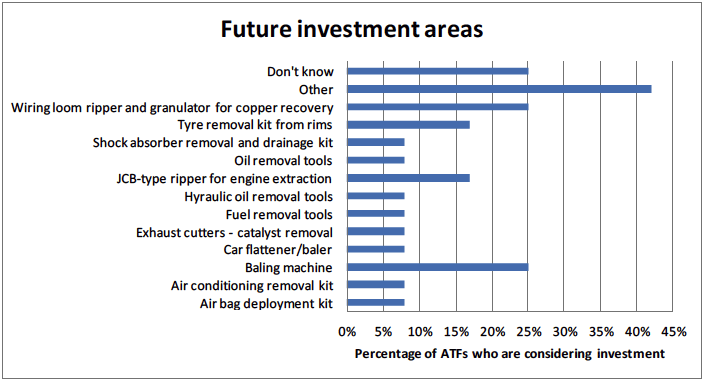
Figure 30 - Types of processing equipment under consideration for future investment (12 responses)
Of those answering 'other' the responses included:
- Decontamination unit
- Petrol/water separator
- Loader for stacking cars
- Fork-lift Truck
- Pre-shredder
It is interesting to note that there is a low proportion of ATFs considering investing in air conditioning removal kit even though the earlier figure 19 suggests that few ATFs currently have such equipment available. Given that the removal of air conditioning gases is a mandatory legislative requirement this suggests that some ATFs are not complying fully with regulations.
3.8 Issues with ELV regulationsRespondents were asked if there were any issues with current ELV regulations which, if addressed, could increase commercial opportunities for their companies. Figure 31, below, summarises the responses.
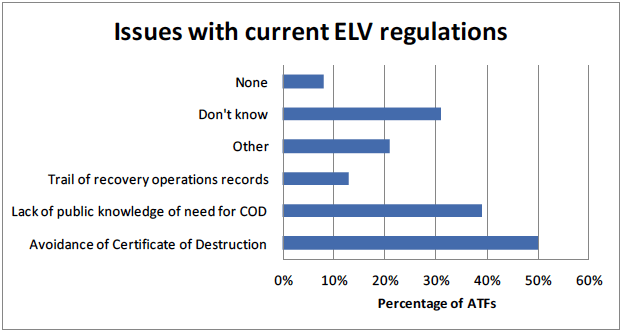
Figure 31 - Issues with current ELV regulations that impact on commercial opportunities (72 responses)
The above figure clearly demonstrates that the COD system is a key issue for ATFs.
Of those who responded 'other', the majority made comments about the presence of unauthorised operators damaging their business.
3.9 Shredder operationsFour of the larger shredder operators in Scotland have been interviewed (either face-to-face or via telephone) to ensure the information was as accurate as can be expected in an industry where inputs are variable dependent on economic activity.
A summary of the ELV inputs and outputs was provided in figure 25. Starting with a shredder input of 97,700 tonnes from ELV sources, the operators already separate for recycling 77,350 tonnes (79%), leaving a landfill residue of 20,350 tonnes (21%). Note this only refers to shredder residue from ELVs (total shredder residue from all input sources is estimated to be in the region of 60,000 tonnes p.a.).
All four would like to see a Scottish solution to the problem of having to source an alternative to landfill for non-recoverable material. While there seems to be an emerging market of companies based in England offering the ability to treat shredder residue to the point of contributing to the 95% target, this is likely to be at a cost of around £70/tonne. The additional transport cost means that this option is currently unattractive, compared to landfill. That will change once the landfill tax escalator impacts further.
Feedback from the four shredder operators interviewed indicates:-
- One is pessimistic about being able to reach the 95% level unless energy production is utilised
- Two think it can just about be done by additional investment in sorting plant, with subsequent energy recovery
- Another thinks as the two above, but with a greater focus on material use, which the others may see as landfill residue ( e.g. fines and glass)
A common theme is energy production from the residue, and possibly other materials such as tyres, which have uncertain markets. The high calorific value of ASR (mainly due to plastic content) could be an issue with its use in energy production, which may require blending with other materials with a lower calorific value - "The large PVC content (that can be up to 20%-wt in some ASRs) will put restrictions on thermal processing of ASR for reasons of equipment corrosion risks. Problematic compounds in ASR that often leads to its classification as hazardous waste are PCBs........a third problematic ASR fraction are trace elements and heavy metals" [40] .
Forthcoming transposition of the Industrial Emissions Directive into UK law, through a revised Integrated Pollution Prevention and Control ( IPPC) regime, is likely to have an impact on the treatment of ASR produced by shredders with a capacity exceeding 75 tonnes per day (indirectly, through less resources being available to the shredders to invest in further PST). This applies to new sites operational after January 2013 and will be phased in for existing plants from 07/01/2014. SEPA are working with the industry to produce a Best Available Technology Reference document ( BREF) to reflect what can be done on a technical basis to reduce waste. Estimates from industry suggest that implementation costs will be hundreds of thousands of pounds (which may impact on availability of investment capital for PST processes, unless this is covered in the BREF document).
Contact
There is a problem
Thanks for your feedback